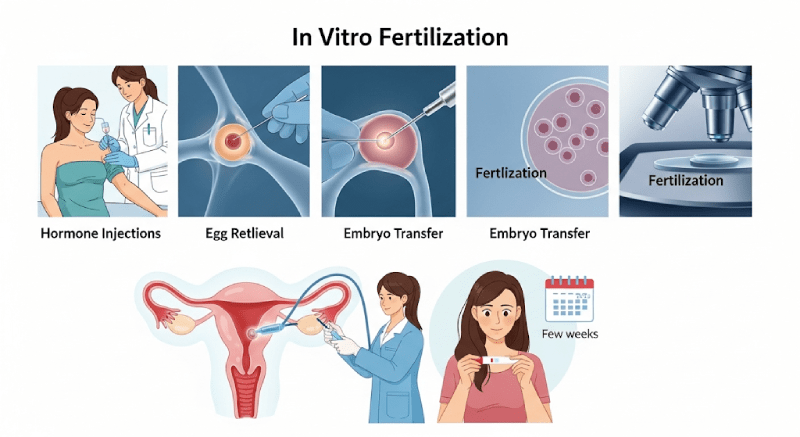Navigating the IVF Journey in the UK: A Financial and Emotional Maze
Individuals and couples seeking assisted reproductive treatment in the United Kingdom (UK) face significant emotional and financial pressure. This process is not merely a medical intervention but a life-changing journey that also brings with it deep personal and financial anxieties. Widespread patient surveys reveal that this journey often leads to trauma and debt. This report aims to illuminate the process with transparent, data-driven information to enable patients to make informed decisions. The goal is to provide a detailed breakdown of costs in the UK, expose the systemic barriers within the National Health Service (NHS), and transparently compare the growing overseas IVF market.
The UK IVF Market: A Tale of Two Systems
There are two main routes for IVF treatment in the UK: the NHS-funded route and the private, self-funded route. These two paths are characterized by fundamental inequalities and financial difficulties, creating distinct differences in the patient experience.
The NHS Route: Understanding the ‘Postcode Lottery’
Despite national guidelines issued by the National Institute for Health and Care Excellence (NICE), the final decision on NHS IVF funding rests with local Integrated Care Boards (ICBs). This creates a fragmented system where a patient’s eligibility for funding is determined by their place of residence rather than their clinical need. For example, while patients in Scotland can access three full cycles even if one partner has a child from a previous relationship, couples in England generally must be childless. This leaves patients feeling vulnerable and confused by the system.
The NHS criteria are strict and unforgiving, precluding many patients from this path. Typically, some of the criteria that patients must meet include:
- Age: Women generally must be between 23 and 42 years old. Women aged 40-42 are typically offered one full cycle of funding if they have not had previous IVF treatment.
- Body Mass Index (BMI): A BMI band of 19 to 29.9 is applied for women, and below 30 for men.
- Childless Rule: Both parties of the couple must not have children themselves, including from previous relationships.
- Lifestyle Factors: It is mandatory for both partners to be non-smokers.
Long waiting times in the system are also a significant problem. Eligible patients can face waiting times of a few months to up to three years for treatment to begin, depending on where they live. The strict waiting time standards applied in Scotland aim for 90 percent of patients to be screened within 52 weeks of referral. This highlights a major barrier created by bureaucratic delays against the urgency of the biological clock. Even more concerning is the fact that the rate of NHS-funded IVF cycles has fallen from 35 percent in 2019 to 27 percent in 2023. This trend is pushing an increasing number of patients towards the private sector, where they will be exposed to the financial pressures mentioned earlier.

The Private Route: Decoding the True Cost
Private clinics are free to set their own price lists, which leads to large variations in pricing. There is a startling discrepancy between the advertised prices and what patients actually pay. The average advertised IVF package cost is £3,898, while the true cost, when all necessary components are added, is 36 percent higher, at £5,310. When additional expenses like pre-treatment examinations and medications are included, the total average cost rises to £7,545.
However, patient surveys reveal that the total cost of an average patient’s IVF journey is much higher. According to the surveys, patients spend an average of £13,750, with 12 percent of couples spending over £30,000. This higher figure reflects the real cost of a full fertility journey, which often includes multiple cycles and add-ons, not just the advertised or basic cost of a single IVF cycle.
The impact of this cost is profound and traumatic. Research shows that 70 percent of individuals undergoing IVF treatment experience financial trauma, and 78 percent go into debt to fund their treatment. Couples are taking desperate financial measures such as cashing in pension funds, remortgaging their homes, maxing out credit cards, or even spending money gifted for their wedding on treatment. This is an effort with no guaranteed success, which reinforces a cycle of debt and trauma.
The Hidden Costs of IVF: A Guide to ‘Add-ons’
Beyond the basic package pricing, there are numerous “add-ons” that can significantly increase costs. These are services that are often claimed to improve the chances of success, but their clinical benefits are not always clear. These add-ons are a primary reason for the lack of transparency in pricing.
| Add-on Service | Typical Cost (GBP) |
| ICSI (Intracytoplasmic Sperm Injection) | £800 – £1,675 |
| Blastocyst Culture (5-day embryo transfer) | £500 – £700 , £560 (average) |
| EmbryoGlue | £130 – £360 , £275 (average) |
| Endometrial Scratch | £200 – £450 |
| PGT-A (Preimplantation Genetic Testing for Aneuploidy) | £2,000 – £3,000 + additional fee per embryo |
| EmbryoScope (Time-Lapse Monitoring) | £750 – £1,150 |
| FER (Frozen Embryo Transfer) | £1,500 – £2,000 , £920 – £3,000 (advertised package) |
| ERA Test (Endometrial Receptivity Array) | £950 – £1,250 |
A Comprehensive Breakdown of IVF Treatment Costs
The financial picture of IVF does not end with the price of a single package. Here is a more detailed breakdown of the various expenses that make up the potential costs of a full treatment cycle.
- Core Treatment Costs:
- A “package” typically includes monitoring ultrasounds, egg collection, embryology, blastocyst culture, and fresh embryo transfer. However, some packages are based on stricter patient criteria; for example, “Pure” packages that require a lower BMI and specific AMH levels. “IVF Plus” packages, designed for less suitable patients, come with a higher price tag. The costs of a single cycle in the UK can range from £3,735 to £13,408.
- Ancillary and Associated Expenses:
- Diagnostic Tests and Consultations: Before treatment, patients need to undergo extensive testing. These can include AMH tests ranging from £35 to £560 and initial consultations ranging from £150 to £395. Costs for male and female fertility MOTs can go up to £225 to £1,050.
- Medication Costs: Medications are usually not included in the advertised package price and can add an extra cost of £900 to £1,200 per cycle.
- Embryo Storage and Frozen Embryo Transfer (FET): After a successful fresh cycle, freezing surplus embryos is a separate expense. The annual cost for embryo storage is £360, and a single FET cycle can range from £920 to £3,000.
- Unseen Costs: There are also costs such as travel, taking time off work, and special medical insurance for medical emergencies. These unseen expenses further increase a patient’s financial and emotional burden.

IVF Success Rates: A Patient’s Guide to the Data
The success of IVF treatment is as complex as its cost. The Human Fertilisation and Embryology Authority (HFEA) mandates that all licensed clinics in the UK report their success rates. However, it is important to understand that different clinics may report data based on different criteria. This makes it difficult to compare “births per embryo transfer” with “births per egg collection.” Patients need to look for figures relevant to their own age group and situation.
Success rates vary significantly with age. HFEA data show that the highest pregnancy rate in patients using fresh embryo transfers is 41 percent in the 18-34 age group. This rate drops significantly for women aged 40 and over. The HFEA also noted concerning disparities in success rates among ethnic groups, with Asian and Black patients having lower birth rates compared to White and mixed-ethnicity patients. These inequalities show that more effort is needed to ensure equal access to treatment and outcomes.
This data directly links the financial burden with the chances of success. Since success is often not achieved in a single cycle, it depends on undergoing more cycles and the increasing costs associated with them.
Beyond Borders: The Growing Allure of the ‘Cure Holiday’
Given the challenges in the UK, an increasing number of patients are choosing to travel abroad for IVF treatment. This trend has given rise to the concept of a “Cure holiday,” which combines traditional tourism with a medical purpose. Patients opt to go abroad for three main reasons:
- Cost-Effectiveness: IVF abroad can cost only a fraction of the price in the UK. For example, a cycle in countries like Spain, Greece, and the Czech Republic can cost well below even the advertised packages in the UK.
- Shorter Waiting Times: Many clinics abroad offer immediate access to treatment, bypassing NHS waiting lists that can last for months or even years. This is critically important for patients, especially in situations where time is of the essence due to age.
- Wider Access to Services: Clinics abroad often offer a wider database of donor eggs and sperm. Some countries have fewer restrictions on donor anonymity, which can make the process smoother. Additionally, some advanced technologies, such as genetic screening, may be more widely available.
| Criterion | United Kingdom | Popular Overseas Destinations (Example) |
| Total Average Cost | £13,750 (Patient Report) | £2,500 – £6,000 (Advertised Price Per Cycle) |
| Waiting Times | Up to 3 years NHS waiting lists | Almost non-existent, can start within a few weeks |
| Donor Access | Limited and may have waiting lists | Extensive donor pool, shorter waiting times |
| Legal Framework | Strictly regulated by HFEA | Varies by country, donor anonymity may differ |
The Risks and Logistics of a ‘Cure Holiday’
While treatment abroad is an attractive option, it requires careful planning and risk management. It is vital that patients conduct extensive research when considering this option.
- Legal and Ethical Differences: Clinics abroad are not regulated by the HFEA. Legal frameworks vary significantly, from donor anonymity to the legal status of embryos. The legal status of a child born, especially when using donor eggs or sperm, can be complex. It is important to seek legal advice and understand how to secure a parental order.
- Communication and Logistics: The stress of language barriers and navigating a foreign healthcare system can add to the emotional burden. However, many leading clinics have dedicated international patient care teams to assist patients. It is possible to arrange remote video consultations in advance and have necessary tests done in the UK, then send the results by email.
- Follow-up Care: Post-treatment follow-up care can pose a challenge, especially if complications arise. Patients need to have a plan for continued care with a local provider upon their return to the UK.
- Legal Protections: The HFEA has no jurisdiction over a complaint about treatment carried out abroad. Therefore, it is important for patients to find out in advance how complaints will be handled if something goes wrong.
Conclusion: Making an Informed Decision
Patients seeking IVF treatment in the United Kingdom face significant barriers due to the NHS system’s postcode lottery, strict eligibility criteria, and long waiting times. The private sector is characterized by costs that often exceed expectations and add-ons not included in advertised packages, leading to financial trauma and debt. These challenges are leading many patients to consider overseas options, which offer higher success rates, shorter waiting times, and lower costs.
Taking a “Cure Holiday” not only reduces cost but also provides access to a more personalized and efficient process. However, before embarking on this journey, it is vital to thoroughly research and manage potential risks such as legal differences, language barriers, and follow-up care. With due diligence, a Cure Holiday can become a valid, high-quality, and cost-effective solution that offers greater predictability and peace of mind for patients facing systemic barriers to building a family in the UK.



